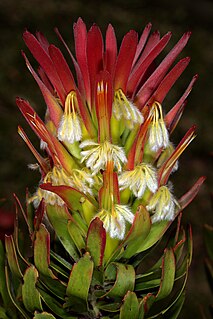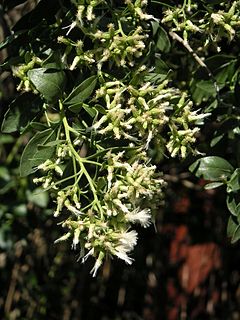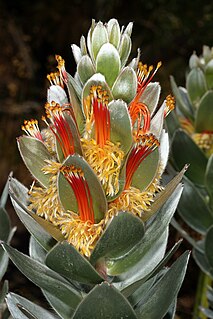Related Research Articles

An inflorescence is a group or cluster of flowers arranged on a stem that is composed of a main branch or a complicated arrangement of branches. Morphologically, it is the modified part of the shoot of seed plants where flowers are formed. The modifications can involve the length and the nature of the internodes and the phyllotaxis, as well as variations in the proportions, compressions, swellings, adnations, connations and reduction of main and secondary axes. One can also define an inflorescence as the reproductive portion of a plant that bears a cluster of flowers in a specific pattern.

Iva annua, the annual marsh elder or sumpweed, is a North American herbaceous annual plant in the sunflower family that was historically cultivated by Native Americans for its edible seed.

A pseudanthium is an inflorescence that resembles a flower. The word is sometimes used for other structures that are neither a true flower nor a true inflorescence. Examples of pseudanthia include flower head, composite flower, or capitulum, which are special types of inflorescences in which anything from a small cluster to hundreds or sometimes thousands of flowers are grouped together to form a single flower-like structure. Pseudanthia take various forms. The real flowers are generally small and often greatly reduced, but the pseudanthium itself can sometimes be quite large.
Banksia epimicta is a species of prostrate shrub that is endemic to a small area in the south-west of Western Australia. It has crowded, sharply pointed pinnatifid leaves, large heads of unpleasantly scented, creamy white and pale yellow flowers and a small number of follicles.

Iva is a genus of wind-pollinated plants in the daisy family, described as a genus by Linnaeus in 1753. Plants of this genus are known generally as marsh elders. The genus is native to North America.

Mimetes, the pagoda, is a genus of evergreen shrubs or small trees 0.5–6 m (1.6–19.7 ft) high, with thirteen species assigned to the family Proteaceae. This genus, as with other proteas, is popular with nectarivorous birds such as the Cape sugarbird and several sunbird species. All species of Mimetes are endemic to the Cape Floristic Region of South Africa.
Xolocotzia is a monotypic genus of flowering plants in the family Verbenaceae containing the single species Xolocotzia asperifolia. This plant, a shrub or small tree, is native to Mexico and Honduras; it has been collected only once in the latter.

Baccharis halimifolia is a North American species of shrubs in the daisy family. It is native to Nova Scotia, the eastern and southern United States, eastern Mexico, the Bahamas, and Cuba.

Iva frutescens is a species of flowering plant in the aster family known by the common names Jesuit's bark, bigleaf marsh-elder, and high-tide bush. It grows in coastal eastern North America from Nova Scotia down the eastern coast and along the Gulf Coast to Texas.

Iva imbricata is a North American species of flowering plant in the aster family known by the common names dune marsh-elder and seacoast marsh elder. It is native to Cuba, the Bahamas, and coastal areas of the United States from Texas to Virginia. It is a low shrub, found on sand dunes and the upper beach. It is a highly salt tolerant plant, and is often the perennial plant closest to the ocean.
Iva angustifolia is a species of flowering plant in the daisy family known by the common name narrowleaf marsh elder. It grows in the south-central and southeastern United States.

Iva axillaris, called povertyweed or death weed, is a North American species of flowering plants in the daisy family. It grows in the western and central United States and in western Canada, from British Columbia south to California and east as far as the western Great Plains in the Texas Panhandle, Nebraska, the Dakotas, and Manitoba. It has also become established in Australia, where it is considered a weed.
Iva microcephala, the piedmont marsh elder, is a North American species of flowering plants in the daisy family. It grows in the southeastern United States in Alabama, Florida, Georgia, and the Carolinas.

Isopogon uncinatus, commonly known as Albany cone bush, is a species of flowering plant in the family Proteaceae and is endemic to a restricted area near Albany in Western Australia. It is a small shrub with very short stems, linear to egg-shaped leaves with the narrower end towards the base, and spherical heads of yellowish flowers. It is the rarest isopogon and was thought to be extinct until rediscovered in the 1980s.

Petrophile aculeata is a species of flowering plant in the family Proteaceae and is endemic to southwestern Western Australia. It is a small shrub with narrow egg-shaped leaves with the narrower end towards the base and with irregular teeth near the end, and more or less spherical heads of hairy yellow flowers.
Petrophile nivea is a species of flowering plant in the family Proteaceae and is endemic to southwestern Western Australia. It is a small shrub with crowded cylindrical, sharply-pointed leaves and more or less spherical heads of hairy white or cream-coloured flowers on the ends of branchlets.

Mimetes hottentoticus is an evergreen, upright shrub of 1½–3 m (5–10 ft) high from the family Proteaceae. It has silvery, broadly egg-shaped to egg-shaped leaves with three small teeth crowded at the tip. The flower heads and subtending leaves form a cylindric inflorescence, topped with a tuft of smaller, more or less upright silvery or pinkish leaves. Each flowerhead contains 8–12 flowers with conspicuously red styles, that are all parallel, projected straight up, pushing against the leaf subtending the higher flowerhead. The styles end in a short white zone topped by a thick blackish pollen presenter. Flowers can usually be found from January till March, few may persist into May. It is called silver pagoda or matchstick pagoda in English and Hottentotstompie in Afrikaans.

Mimetes stokoei, the mace pagoda, is an evergreen, upright, hardly branching, large shrub of 1–2 m high in the family Proteaceae. It has silvery, oval leaves of 5–8 cm (2.0–3.2 in) long and 2 1⁄2–4 cm (1.0–1.6 in) wide, with one large tooth supported by two smaller teeth near the tip, at an upward angle and somewhat overlapping each other. The inflorescences are set just below the growing tip, are cylinder-shaped, 10–12 cm (4–5 in) high, topped by a crest of small, more or less horizontal, pinkish-purple tinged leaves. It consists of several flower heads in the axils of golden leaves with a pinkish wash that form a hood shielding the underlying flower head. Each flower head contains eight to twelve individual flowers, with amber-colored styles topped by blackish purple pollen presenters and grey silky perianth lobes. It is endemic to the Fynbos ecoregion of South Africa, being confined to the Kogelberg mountain range. The mace pagoda was twice presumed extinct, but reappeared in its natural habitat from seed, after a wildfire several decades later.
Protea pruinosa, also known as frosted sugarbush or burnished protea, is a flowering shrub which belongs to the genus Protea within the botanical family Proteaceae. The plant is endemic to the southwestern Cape Region of South Africa.

Cornus asperifolia, called toughleaf dogwood, is species of Cornus native to the southeastern United States. A shrub or small tree typically 3 to 5 m tall, it has yellow‑white flowers and white fruit.
References
- ↑ "Iva asperifolia". Natural Resources Conservation Service PLANTS Database. USDA . Retrieved 7 August 2015.
- ↑ Tropicos, Iva asperifolia Less.
- ↑ Biota of North America Program 2014 county distribution map
- ↑ Lessing, Christian Friedrich 1830. In: Linnaea 5(1): 151 in Latin